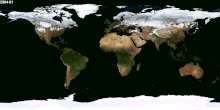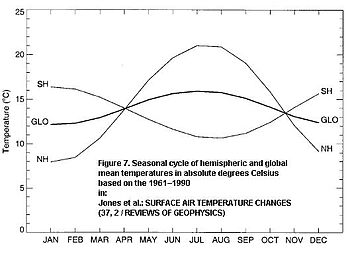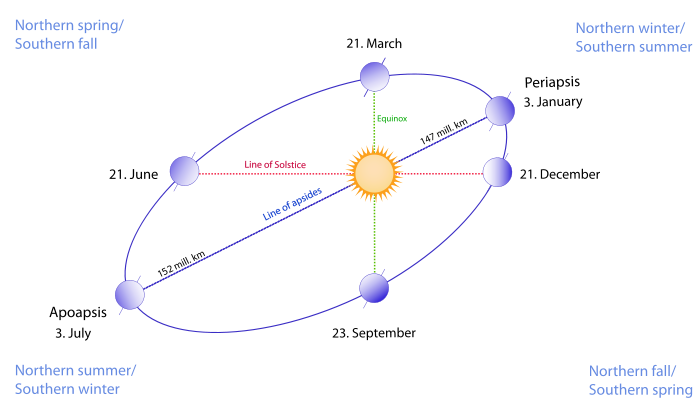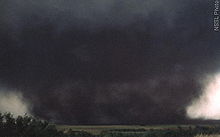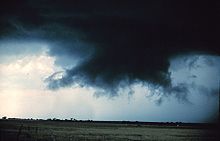
A tornado near
Anadarko, Oklahoma. The
funnel is the thin tube reaching from the cloud to the ground. The lower part of this tornado is surrounded by a
translucent dust cloud, kicked up by the tornado's strong winds at the surface. The wind of the tornado has a much wider radius than the funnel itself.
A
tornado is a violently rotating column of
air that is in contact with both the surface of the earth and a
cumulonimbus cloud or, in rare cases, the base of a
cumulus cloud. They are often referred to as
twisters or
cyclones,
[1] although the word
cyclone is used in meteorology, in a wider sense, to name any closed
low pressure circulation. Tornadoes come in many shapes and sizes, but they are typically in the form of a visible
condensation funnel, whose narrow end touches the earth and is often encircled by a cloud of
debris and
dust. Most tornadoes have wind speeds less than 110 miles per hour (177 km/h), are about 250 feet (76 m) across, and travel a few miles (several kilometers) before dissipating. The
most extreme tornadoes can attain wind speeds of more than 300 miles per hour (483 km/h), stretch more than two miles (3.2 km) across, and stay on the ground for dozens of miles (more than 100 km).
[2][3][4]
Various types of tornadoes include the
landspout,
multiple vortex tornado, and
waterspout. Waterspouts are characterized by a spiraling funnel-shaped wind current, connecting to a large cumulus or cumulonimbus cloud. They are generally classified as non-
supercellular tornadoes that develop over bodies of water, but there is disagreement over whether to classify them as true tornadoes. These spiraling columns of air frequently develop in tropical areas close to the
equator, and are less common at
high latitudes.
[5] Other tornado-like phenomena that exist in nature include the
gustnado,
dust devil,
fire whirls, and
steam devil;
downbursts are frequently confused with tornadoes, though their action is dissimilar.
Tornadoes have been observed on every continent except Antarctica. However, the vast majority of tornadoes occur in the
Tornado Alley region of the
United States, although they can occur nearly anywhere in North America.
[6] They also occasionally occur in south-central and eastern Asia, northern and east-central South America,
Southern Africa, northwestern and southeast Europe, western and southeastern Australia, and New Zealand.
[7] Tornadoes can be detected before or as they occur through the use of
Pulse-Doppler radar by recognizing patterns in velocity and reflectivity data, such as
hook echoes or
debris balls, as well as through the efforts of
storm spotters.
There are several scales for rating the strength of tornadoes. The
Fujita scale rates tornadoes by damage caused and has been replaced in some countries by the updated
Enhanced Fujita Scale. An F0 or EF0 tornado, the weakest category, damages trees, but not substantial structures. An F5 or EF5 tornado, the strongest category, rips buildings off their foundations and can deform large
skyscrapers. The similar
TORRO scale ranges from a T0 for extremely weak tornadoes to T11 for the most powerful known tornadoes.
[8] Doppler
radar data,
photogrammetry, and ground swirl patterns (
cycloidal marks) may also be analyzed to determine intensity and assign a rating.
[9][10]
Etymology
The word
tornado is an altered form of the Spanish word
tronada, which means "thunderstorm". This in turn was taken from the Latin
tonare, meaning "to thunder". It most likely reached its present form through a combination of the Spanish
tronada and
tornar ("to turn"); however, this may be a
folk etymology.
[11][12] A tornado is also commonly referred to as a "twister", and is also sometimes referred to by the old-fashioned colloquial term
cyclone.
[13][14] The term "cyclone" is used as a synonym for "tornado" in the often-aired 1939 film
The Wizard of Oz. The term "twister" is also used in that film, along with being the title of the 1996 tornado-related film
Twister.
Definitions
A tornado is "a violently rotating column of air, in contact with the ground, either pendant from a
cumuliform cloud or underneath a cumuliform cloud, and often (but not always) visible as a funnel cloud".
[15] For a vortex to be classified as a tornado, it must be in contact with both the ground and the cloud base. Scientists have not yet created a complete definition of the word; for example, there is disagreement as to whether separate touchdowns of the same funnel constitute separate tornadoes.
[4] Tornado refers to the
vortex of wind, not the condensation cloud.
[16][17]
Funnel cloud

This tornado has no funnel cloud; however, the rotating dust cloud indicates that strong winds are occurring at the surface, and thus it is a true tornado.
A tornado is not necessarily visible; however, the intense low pressure caused by the high wind speeds (as described by
Bernoulli's principle) and rapid rotation (due to
cyclostrophic balance) usually causes
water vapor in the air to condense into cloud droplets due to
adiabatic cooling. This results in the formation of a visible funnel cloud or condensation funnel.
[18]
There is some disagreement over the definition of funnel cloud and condensation funnel. According to the
Glossary of Meteorology, a funnel cloud is any rotating cloud pendant from a cumulus or cumulonimbus, and thus most tornadoes are included under this definition.
[19] Among many meteorologists, the funnel cloud term is strictly defined as a rotating cloud which is not associated with strong winds at the surface, and condensation funnel is a broad term for any rotating cloud below a cumuliform cloud.
[4]
Tornadoes often begin as funnel clouds with no associated strong winds at the surface, and not all funnel clouds evolve into tornadoes. Most tornadoes produce strong winds at the surface while the visible funnel is still above the ground, so it is difficult to discern the difference between a funnel cloud and a tornado from a distance.
[4]
Outbreaks and families
Occasionally, a single storm will produce more than one tornado, either simultaneously or in succession. Multiple tornadoes produced by the same
storm cell are referred to as a "tornado family".
[20] Several tornadoes are sometimes spawned from the same large-scale storm system. If there is no break in activity, this is considered a tornado outbreak (although the term "tornado outbreak" has various definitions). A period of several successive days with tornado outbreaks in the same general area (spawned by multiple weather systems) is a tornado outbreak sequence, occasionally called an extended tornado outbreak.
[15][21][22]
Characteristics
Size and shape
Most tornadoes take on the appearance of a narrow
funnel, a few hundred yards (meters) across, with a small cloud of debris near the ground. Tornadoes may be obscured completely by rain or dust. These tornadoes are especially dangerous, as even experienced meteorologists might not see them.
[23] Tornadoes can appear in many shapes and sizes.
Small, relatively weak landspouts may be visible only as a small swirl of dust on the ground. Although the condensation funnel may not extend all the way to the ground, if associated surface winds are greater than 40 mph (64 km/h), the circulation is considered a tornado.
[16] A tornado with a nearly cylindrical profile and relative low height is sometimes referred to as a "stovepipe" tornado. Large single-vortex tornadoes can look like large
wedges stuck into the ground, and so are known as "wedge tornadoes" or "wedges". The "stovepipe" classification is also used for this type of tornado, if it otherwise fits that profile. A wedge can be so wide that it appears to be a block of dark clouds, wider than the distance from the cloud base to the ground. Even experienced storm observers may not be able to tell the difference between a low-hanging cloud and a wedge tornado from a distance. Many, but not all major tornadoes are wedges.
[24]
Tornadoes in the dissipating stage can resemble narrow tubes or ropes, and often curl or twist into complex shapes. These tornadoes are said to be "roping out", or becoming a "rope tornado". When they rope out, the length of their funnel increases, which forces the winds within the funnel to weaken due to
conservation of angular momentum.
[25] Multiple-vortex tornadoes can appear as a family of swirls circling a common center, or they may be completely obscured by condensation, dust, and debris, appearing to be a single funnel.
[26]
In the United States, tornadoes are around 500 feet (150 m) across on average and travel on the ground for 5 miles (8.0 km).
[23] However, there is a wide range of tornado sizes. Weak tornadoes, or strong yet dissipating tornadoes, can be exceedingly narrow, sometimes only a few feet or couple meters across. One tornado was reported to have a damage path only 7 feet (2 m) long.
[23] On the other end of the spectrum, wedge tornadoes can have a damage path a mile (1.6 km) wide or more. A
tornado that affected Hallam, Nebraska on May 22, 2004, was up to 2.5 miles (4.0 km) wide at the ground, and
a tornado in El Reno, Oklahoma on May 31, 2013 was approximately 2.6 miles (4.2 km) wide, the widest on record.
[3][27]
In terms of path length, the
Tri-State Tornado, which affected parts of
Missouri,
Illinois, and
Indiana on March 18, 1925, was on the ground continuously for 219 miles (352 km). Many tornadoes which appear to have path lengths of 100 miles (160 km) or longer are composed of a family of tornadoes which have formed in quick succession; however, there is no substantial evidence that this occurred in the case of the Tri-State Tornado.
[21] In fact, modern reanalysis of the path suggests that the tornado may have begun 15 miles (24 km) further west than previously thought.
[28]
Appearance
Tornadoes can have a wide range of colors, depending on the environment in which they form. Those that form in dry environments can be nearly invisible, marked only by swirling debris at the base of the funnel. Condensation funnels that pick up little or no debris can be gray to white. While traveling over a body of water (as a waterspout), tornadoes can turn very white or even blue. Slow-moving funnels, which ingest a considerable amount of debris and dirt, are usually darker, taking on the color of debris. Tornadoes in the
Great Plains can turn red because of the reddish tint of the soil, and tornadoes in mountainous areas can travel over snow-covered ground, turning white.
[23]
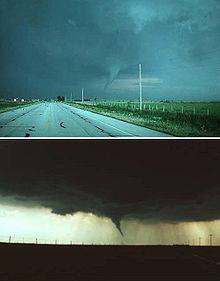
Photographs of the
Waurika, Oklahoma tornado of May 30, 1976, taken at nearly the same time by two photographers. In the top picture, the tornado is lit with the sunlight focused from behind the
camera, thus the funnel appears bluish. In the lower image, where the camera is facing the opposite direction, the sun is behind the tornado, giving it a dark appearance.
[29]
Lighting conditions are a major factor in the appearance of a tornado. A tornado which is "
back-lit" (viewed with the sun behind it) appears very dark. The same tornado, viewed with the sun at the observer's back, may appear gray or brilliant white. Tornadoes which occur near the time of sunset can be many different colors, appearing in hues of yellow, orange, and pink.
[13][30]
Dust kicked up by the winds of the parent thunderstorm, heavy rain and hail, and the darkness of night are all factors which can reduce the visibility of tornadoes. Tornadoes occurring in these conditions are especially dangerous, since only
weather radar observations, or possibly the sound of an approaching tornado, serve as any warning to those in the storm's path. Most significant tornadoes form under the storm's
updraft base, which is rain-free,
[31] making them visible.
[32] Also, most tornadoes occur in the late afternoon, when the bright sun can penetrate even the thickest clouds.
[21] Night-time tornadoes are often illuminated by frequent lightning.
There is mounting evidence, including
Doppler On Wheels mobile radar images and eyewitness accounts, that most tornadoes have a clear, calm center with extremely low pressure, akin to the
eye of
tropical cyclones. Lightning is said to be the source of illumination for those who claim to have seen the interior of a tornado.
[33][34][35]
Rotation
Tornadoes normally rotate
cyclonically (when viewed from above, this is counterclockwise in the
northern hemisphere and clockwise in the
southern). While large-scale storms always rotate cyclonically due to the
Coriolis effect, thunderstorms and tornadoes are so small that the direct influence of the Coriolis effect is unimportant, as indicated by their large
Rossby numbers. Supercells and tornadoes rotate cyclonically in numerical simulations even when the Coriolis effect is neglected.
[36][37] Low-level
mesocyclones and tornadoes owe their rotation to complex processes within the supercell and ambient environment.
[38]
Approximately 1 percent of tornadoes rotate in an anticyclonic direction in the northern hemisphere. Typically, systems as weak as landspouts and gustnadoes can rotate anticyclonically, and usually only those which form on the anticyclonic shear side of the descending
rear flank downdraft (RFD) in a cyclonic supercell.
[39] On rare occasions,
anticyclonic tornadoes form in association with the mesoanticyclone of an anticyclonic supercell, in the same manner as the typical cyclonic tornado, or as a companion tornado either as a satellite tornado or associated with anticyclonic eddies within a supercell.
[40]
Sound and seismology
Tornadoes emit widely on the
acoustics spectrum and the sounds are caused by multiple mechanisms. Various sounds of tornadoes have been reported, mostly related to familiar sounds for the witness and generally some variation of a whooshing roar. Popularly reported sounds include a freight train, rushing rapids or waterfall, a nearby jet engine, or combinations of these. Many tornadoes are not audible from much distance; the nature and propagation distance of the audible sound depends on atmospheric conditions and topography.
The winds of the tornado vortex and of constituent turbulent
eddies, as well as airflow interaction with the surface and debris, contribute to the sounds. Funnel clouds also produce sounds. Funnel clouds and small tornadoes are reported as whistling, whining, humming, or the buzzing of innumerable bees or electricity, or more or less harmonic, whereas many tornadoes are reported as a continuous, deep rumbling, or an irregular sound of "noise".
[41]
Since many tornadoes are audible only when very near, sound is not reliable warning of a tornado. Tornadoes are also not the only source of such sounds in severe thunderstorms; any strong, damaging wind, a severe hail volley, or continuous thunder in a thunderstorm may produce a roaring sound.
[42]
Tornadoes also produce identifiable inaudible
infrasonic signatures.
[43]
Unlike audible signatures, tornadic signatures have been isolated; due to the long distance propagation of low-frequency sound, efforts are ongoing to develop tornado prediction and detection devices with additional value in understanding tornado morphology, dynamics, and creation.
[44] Tornadoes also produce a detectable
seismic signature, and research continues on isolating it and understanding the process.
[45]
Electromagnetic, lightning, and other effects
Tornadoes emit on the
electromagnetic spectrum, with
sferics and
E-field effects detected.
[44][46][47] There are observed correlations between tornadoes and patterns of lightning. Tornadic storms do not contain more lightning than other storms and some tornadic cells never produce lightning. More often than not, overall cloud-to-ground (CG) lightning activity decreases as a tornado reaches the surface and returns to the baseline level when the tornado lifts. In many cases, intense tornadoes and thunderstorms exhibit an increased and anomalous dominance of positive polarity CG discharges.
[48] Electromagnetics and lightning have little or nothing to do directly with what drives tornadoes (tornadoes are basically a
thermodynamic phenomenon), although there are likely connections with the storm and environment affecting both phenomena.
Luminosity has been reported in the past and is probably due to misidentification of external light sources such as lightning, city lights, and
power flashes from broken lines, as internal sources are now uncommonly reported and are not known to ever have been recorded. In addition to winds, tornadoes also exhibit changes in atmospheric variables such as
temperature,
moisture, and
pressure. For example, on June 24, 2003 near
Manchester, South Dakota, a probe measured a 100
mbar (
hPa) (2.95
inHg) pressure decrease. The pressure dropped gradually as the vortex approached then dropped extremely rapidly to 850
mbar (
hPa) (25.10
inHg) in the core of the violent tornado before rising rapidly as the vortex moved away, resulting in a V-shape pressure trace. Temperature tends to decrease and moisture content to increase in the immediate vicinity of a tornado.
[49]
Life cycle
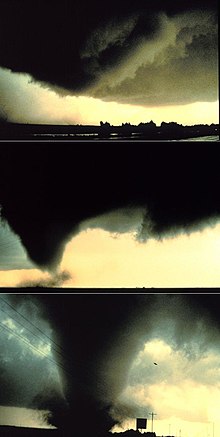
A sequence of images showing the birth of a tornado. First, the rotating cloud base lowers. This lowering becomes a funnel, which continues descending while winds build near the surface, kicking up dust and other debris. Finally, the visible funnel extends to the ground, and the tornado begins causing major damage. This tornado, near
Dimmitt, Texas, was one of the best-observed violent tornadoes in history.
Supercell relationship
Tornadoes often develop from a class of thunderstorms known as supercells. Supercells contain
mesocyclones, an area of organized rotation a few miles up in the atmosphere, usually 1–6 miles (2–10 km) across. Most intense tornadoes (EF3 to EF5 on the
Enhanced Fujita Scale) develop from supercells. In addition to tornadoes, very heavy rain, frequent lightning, strong wind gusts, and hail are common in such storms.
Most tornadoes from supercells follow a recognizable life cycle. That begins when increasing rainfall drags with it an area of quickly descending air known as the rear flank downdraft (RFD). This downdraft accelerates as it approaches the ground, and drags the supercell's rotating mesocyclone towards the ground with it.
[16]
Formation
As the mesocyclone lowers below the cloud base, it begins to take in cool, moist air from the downdraft region of the storm. This convergence of warm air in the updraft, and this cool air, causes a rotating wall cloud to form. The RFD also focuses the mesocyclone's base, causing it to siphon air from a smaller and smaller area on the ground. As the updraft intensifies, it creates an area of low pressure at the surface. This pulls the focused mesocyclone down, in the form of a visible condensation funnel. As the funnel descends, the RFD also reaches the ground, creating a gust front that can cause severe damage a good distance from the tornado. Usually, the funnel cloud begins causing damage on the ground (becoming a tornado) within a few minutes of the RFD reaching the ground.
[16]
Maturity
Initially, the tornado has a good source of warm, moist
inflow to power it, so it grows until it reaches the "mature stage". This can last anywhere from a few minutes to more than an hour, and during that time a tornado often causes the most damage, and in rare cases can be more than one mile (1.6 km) across. Meanwhile, the RFD, now an area of cool surface winds, begins to wrap around the tornado, cutting off the inflow of warm air which feeds the tornado.
[16]
Dissipation
As the RFD completely wraps around and chokes off the tornado's air supply, the vortex begins to weaken, and become thin and rope-like. This is the "dissipating stage", often lasting no more than a few minutes, after which the tornado fizzles. During this stage the shape of the tornado becomes highly influenced by the winds of the parent storm, and can be blown into fantastic patterns.
[21][29][30] Even though the tornado is dissipating, it is still capable of causing damage. The storm is contracting into a rope-like tube and, like the ice skater who pulls her arms in to spin faster, winds can increase at this point.
[25]
As the tornado enters the dissipating stage, its associated mesocyclone often weakens as well, as the rear flank downdraft cuts off the inflow powering it. Sometimes, in intense supercells, tornadoes can develop
cyclically. As the first mesocyclone and associated tornado dissipate, the storm's inflow may be concentrated into a new area closer to the center of the storm. If a new mesocyclone develops, the cycle may start again, producing one or more new tornadoes. Occasionally, the old (occluded) mesocyclone and the new mesocyclone produce a tornado at the same time.
Although this is a widely accepted theory for how most tornadoes form, live, and die, it does not explain the formation of smaller tornadoes, such as landspouts, long-lived tornadoes, or tornadoes with multiple vortices. These each have different mechanisms which influence their development—however, most tornadoes follow a pattern similar to this one.
[50]
Types
Multiple vortex
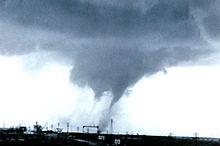
A
multiple-vortex tornado is a type of tornado in which two or more columns of spinning air rotate around a common center. A multi-vortex structure can occur in almost any circulation, but is very often observed in intense tornadoes. These vortices often create small areas of heavier damage along the main tornado path.
[4][16] This is a distinct phenomenon from a
satellite tornado, which is a smaller tornado which forms very near a large, strong tornado contained within the same mesocyclone. The satellite tornado may appear to "
orbit" the larger tornado (hence the name), giving the appearance of one, large multi-vortex tornado. However, a satellite tornado is a distinct circulation, and is much smaller than the main funnel.
[4]
Waterspout

A
waterspout is defined by the
National Weather Service as a tornado over water. However, researchers typically distinguish "fair weather" waterspouts from tornadic waterspouts. Fair weather waterspouts are less severe but far more common, and are similar to dust devils and landspouts. They form at the bases of
cumulus congestus clouds over tropical and subtropical waters. They have relatively weak winds, smooth
laminar walls, and typically travel very slowly. They occur most commonly in the
Florida Keys and in the northern
Adriatic Sea.
[51][52][53] In contrast, tornadic waterspouts are stronger tornadoes over water. They form over water similarly to mesocyclonic tornadoes, or are stronger tornadoes which cross over water. Since they form from
severe thunderstorms and can be far more intense, faster, and longer-lived than fair weather waterspouts, they are more dangerous.
[54] In official tornado statistics, waterspouts are generally not counted unless they affect land, though some European weather agencies count waterspouts and tornadoes together.
[4][55]
Landspout
A
landspout, or
dust-tube tornado, is a tornado not associated with a mesocyclone. The name stems from their characterization as a "fair weather waterspout on land". Waterspouts and landspouts share many defining characteristics, including relative weakness, short lifespan, and a small, smooth condensation funnel which often does not reach the surface. Landspouts also create a distinctively laminar cloud of dust when they make contact with the ground, due to their differing mechanics from true mesoform tornadoes. Though usually weaker than classic tornadoes, they can produce strong winds which could cause serious damage.
[4][16]
Similar circulations
Gustnado

A
gustnado, or
gust front tornado, is a small, vertical swirl associated with a
gust front or
downburst. Because they are not connected with a cloud base, there is some debate as to whether or not gustnadoes are tornadoes. They are formed when fast moving cold, dry outflow air from a
thunderstorm is blown through a mass of stationary, warm, moist air near the outflow boundary, resulting in a "rolling" effect (often exemplified through a
roll cloud). If low level
wind shear is strong enough, the rotation can be turned vertically or diagonally and make contact with the ground. The result is a gustnado.
[4][56] They usually cause small areas of heavier rotational wind damage among areas of straight-line wind damage.
Dust devil
A
dust devil resembles a tornado in that it is a vertical swirling column of air. However, they form under clear skies and are no stronger than the weakest tornadoes. They form when a strong convective updraft is formed near the ground on a hot day. If there is enough low level wind shear, the column of hot, rising air can develop a small cyclonic motion that can be seen near the ground. They are not considered tornadoes because they form during fair weather and are not associated with any clouds. However, they can, on occasion, result in major damage in
arid areas.
[23][57]
Fire whirls
Small-scale, tornado-like circulations can occur near any intense surface heat source. Those that occur near intense
wildfires are called
fire whirls. They are not considered tornadoes, except in the rare case where they connect to a
pyrocumulus or other cumuliform cloud above. Fire whirls usually are not as strong as tornadoes associated with thunderstorms. They can, however, produce significant damage.
[21]
Steam devils
A
steam devil is a
rotating updraft that involves steam or smoke. Steam devils are very rare. They most often form from smoke issuing from a power plant's smokestack.
Hot springs and deserts may also be suitable locations for a steam devil to form. The phenomenon can occur over water, when cold arctic air passes over relatively warm water.
[23]
Intensity and damage
Tornado rating classifications[21][58]
F0
EF0 |
F1
EF1 |
F2
EF2 |
F3
EF3 |
F4
EF4 |
F5
EF5 |
| Weak |
Strong |
Violent |
|
Significant |
|
Intense |
The Fujita scale and the Enhanced Fujita Scale rate tornadoes by damage caused. The Enhanced Fujita (EF) Scale was an update to the older Fujita scale, by
expert elicitation, using engineered wind estimates and better damage descriptions. The EF Scale was designed so that a tornado rated on the Fujita scale would receive the same numerical rating, and was implemented starting in the United States in 2007. An EF0 tornado will probably damage trees but not substantial structures, whereas an EF5 tornado can rip buildings off their foundations leaving them bare and even deform large
skyscrapers. The similar TORRO scale ranges from a T0 for extremely weak tornadoes to T11 for the most powerful known tornadoes.
Doppler weather radar data,
photogrammetry, and ground swirl patterns (
cycloidal marks) may also be analyzed to determine intensity and award a rating.
[4][59][60]
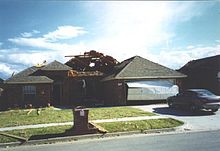
A house displaying
EF1 damage. The roof and
garage door have been damaged, but walls and supporting structures are still intact.
Tornadoes vary in intensity regardless of shape, size, and location, though strong tornadoes are typically larger than weak tornadoes. The association with track length and duration also varies, although longer track tornadoes tend to be stronger.
[61] In the case of violent tornadoes, only a small portion of the path is of violent intensity, most of the higher intensity from
subvortices.
[21]
In the United States, 80% of tornadoes are EF0 and EF1 (T0 through T3) tornadoes. The rate of occurrence drops off quickly with increasing strength—less than 1% are violent tornadoes (EF4, T8 or stronger).
[62] Outside Tornado Alley, and North America in general, violent tornadoes are extremely rare. This is apparently mostly due to the lesser number of tornadoes overall, as research shows that tornado intensity distributions are fairly similar worldwide. A few significant tornadoes occur annually in Europe, Asia, southern Africa, and southeastern South America, respectively.
[63]
Climatology

Areas worldwide where tornadoes are most likely, indicated by orange shading
The United States has the most tornadoes of any country, nearly four times more than estimated in all of Europe, excluding waterspouts.
[64] This is mostly due to the unique geography of the continent. North America is a large continent that extends from the
tropics north into
arctic areas, and has no major east-west mountain range to block air flow between these two areas. In the
middle latitudes, where most tornadoes of the world occur, the
Rocky Mountains block moisture and buckle the
atmospheric flow, forcing drier air at mid-levels of the
troposphere due to downsloped winds, and causing
the formation of a low pressure area downwind to the east of the mountains. Increased westerly flow off the Rockies force the formation of a
dry line when the flow aloft is strong,
[65] while the
Gulf of Mexico fuels abundant low-level moisture in the southerly flow to its east. This unique topography allows for frequent collisions of warm and cold air, the conditions that breed strong, long-lived storms throughout the year. A large portion of these tornadoes form in an area of the
central United States known as
Tornado Alley.
[6] This area extends into
Canada, particularly
Ontario and the
Prairie Provinces, although southeast
Quebec, the interior of
British Columbia, and western
New Brunswick are also tornado-prone.
[66] Tornadoes also occur across northeastern Mexico.
[4]
The United States averages about 1,200 tornadoes per year. The Netherlands has the highest average number of recorded tornadoes per area of any country (more than 20, or 0.0013 per sq mi (0.00048 per km
2), annually), followed by the UK (around 33, or 0.00035 per sq mi (0.00013 per km
2), per year),
[67][68] but most are small and cause minor damage. In absolute number of events, ignoring area, the UK experiences more tornadoes than any other European country, excluding waterspouts.
[64]

Intense tornado activity in the United States. The darker-colored areas denote the area commonly referred to as
Tornado Alley.
Tornadoes kill an average of 179 people per year in
Bangladesh, the most in the world.
[69] This is due to high population density, poor quality of construction and lack of tornado safety knowledge, as well as other factors.
[69][70] Other areas of the world that have frequent tornadoes include South Africa, the
La Plata Basin area, portions of Europe, Australia and New Zealand, and far eastern Asia.
[7][71]
Tornadoes are most common in spring and least common in winter, but tornadoes can occur any time of year that favorable conditions occur.
[21] Spring and fall experience peaks of activity as those are the seasons when stronger winds, wind shear, and atmospheric instability are present.
[72] Tornadoes are focused in the right front quadrant of
landfalling tropical cyclones, which tend to occur in the late summer and autumn. Tornadoes can also be spawned as a result of
eyewall mesovortices, which persist until landfall.
[73]
Tornado occurrence is highly dependent on the time of day, because of
solar heating.
[74] Worldwide, most tornadoes occur in the late afternoon, between 3 pm and 7 pm local time, with a peak near 5 pm.
[75][76][77][78][79] Destructive tornadoes can occur at any time of day. The
Gainesville Tornado of 1936, one of the deadliest tornadoes in history, occurred at 8:30 am local time.
[21]
Associations with climate and climate change
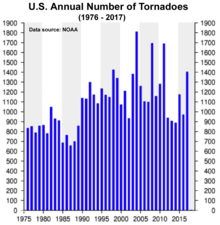
U. S. Annual January - December Tornado Count 1976-2011 from NOAA National Climatic Data Center
Associations with various
climate and environmental trends exist. For example, an increase in the
sea surface temperature of a source region (e.g. Gulf of Mexico and
Mediterranean Sea) increases atmospheric moisture content. Increased moisture can fuel an increase in
severe weather and tornado activity, particularly in the cool season.
[80]
Some evidence does suggest that the
Southern Oscillation is weakly correlated with changes in tornado activity, which vary by season and region, as well as whether the
ENSO phase is that of
El Niño or
La Niña.
[81]
Climatic shifts may affect tornadoes via
teleconnections in shifting the jet stream and the larger weather patterns. The climate-tornado link is confounded by the forces affecting larger patterns and by the local, nuanced nature of tornadoes. Although it is reasonable to suspect that
global warming may affect trends in tornado activity,
[82] any such effect is not yet identifiable due to the complexity, local nature of the storms, and database quality issues. Any effect would vary by region.
[83]
Detection

Path of a tornado across Wisconsin on August 21, 1857
Rigorous attempts to warn of tornadoes began in the United States in the mid-20th century. Before the 1950s, the only method of detecting a tornado was by someone seeing it on the ground. Often, news of a tornado would reach a local weather office after the storm. However, with the advent of weather radar, areas near a local office could get advance warning of severe weather. The first public
tornado warnings were issued in 1950 and the first
tornado watches and
convective outlooks in 1952. In 1953 it was confirmed that
hook echoes are associated with tornadoes.
[84] By recognizing these radar signatures, meteorologists could detect thunderstorms probably producing tornadoes from dozens of miles away.
[85]
Radar
Today, most developed countries have a network of weather radars, which remains the main method of detecting signatures probably associated with tornadoes. In the United States and a few other countries, Doppler weather radar stations are used. These devices measure the velocity and radial
direction (towards or away from the radar) of the winds in a storm, and so can spot evidence of rotation in storms from more than a hundred miles (160 km) away. When storms are distant from a radar, only areas high within the storm are observed and the important areas below are not sampled.
[86] Data resolution also decreases with distance from the radar. Some meteorological situations leading to tornadogenesis are not readily detectable by radar and on occasion tornado development may occur more quickly than radar can complete a scan and send the batch of data. Also, most populated areas on Earth are now visible from the
Geostationary Operational Environmental Satellites (GOES), which aid in the
nowcasting of tornadic storms.
[87]
Storm spotting
In the mid-1970s, the U.S. National Weather Service (NWS) increased its efforts to train
storm spotters to spot key features of storms which indicate severe hail, damaging winds, and tornadoes, as well as damage itself and
flash flooding. The program was called
Skywarn, and the spotters were local sheriff's deputies, state troopers, firefighters, ambulance drivers,
amateur radio operators,
civil defense (now
emergency management) spotters,
storm chasers, and ordinary citizens. When severe weather is anticipated, local weather service offices request that these spotters look out for severe weather, and report any tornadoes immediately, so that the office can warn of the hazard.
Usually spotters are trained by the NWS on behalf of their respective organizations, and report to them. The organizations activate public warning systems such as
sirens and the
Emergency Alert System (EAS), and forward the report to the NWS.
[88] There are more than 230,000 trained Skywarn weather spotters across the United States.
[89]
In Canada, a similar network of volunteer weather watchers, called
Canwarn, helps spot severe weather, with more than 1,000 volunteers.
[87] In Europe, several nations are organizing spotter networks under the auspices of
Skywarn Europe[90] and the Tornado and Storm Research Organisation (TORRO) has maintained a network of spotters in the United Kingdom since 1974.
[91]
Storm spotters are needed because radar systems such as
NEXRAD do not detect a tornado; merely signatures which hint at the presence of tornadoes.
[92] Radar may give a warning before there is any visual evidence of a tornado or imminent tornado, but
ground truth from an observer can either verify the threat or determine that a tornado is not imminent.
[93] The spotter's ability to see what radar cannot is especially important as distance from the radar site increases, because the radar beam becomes progressively higher in altitude further away from the radar, chiefly due to curvature of Earth, and the beam also spreads out.
[86]
Visual evidence
Storm spotters are trained to discern whether a storm seen from a distance is a supercell. They typically look to its rear, the main region of
updraft and inflow. Under the updraft is a rain-free base, and the next step of
tornadogenesis is the formation of a rotating
wall cloud. The vast majority of intense tornadoes occur with a wall cloud on the backside of a supercell.
[62]
Evidence of a supercell comes from the storm's shape and structure, and cloud tower features such as a hard and vigorous updraft tower, a persistent, large
overshooting top, a hard anvil (especially when backsheared against strong upper level
winds), and a corkscrew look or
striations. Under the storm and closer to where most tornadoes are found, evidence of a supercell and likelihood of a tornado includes inflow bands (particularly when curved) such as a "beaver tail", and other clues such as strength of inflow, warmth and moistness of inflow air, how outflow- or inflow-dominant a storm appears, and how far is the front flank precipitation core from the wall cloud. Tornadogenesis is most likely at the interface of the updraft and
rear flank downdraft, and requires a balance between the outflow and inflow.
[16]
Only wall clouds that rotate spawn tornadoes, and usually precede the tornado by five to thirty minutes. Rotating wall clouds may be a visual manifestation of a low-level mesocyclone. Barring a low-level boundary, tornadogenesis is highly unlikely unless a rear flank downdraft occurs, which is usually visibly evidenced by evaporation of
cloud adjacent to a corner of a wall cloud. A tornado often occurs as this happens or shortly after; first, a funnel cloud dips and in nearly all cases by the time it reaches halfway down, a surface swirl has already developed, signifying a tornado is on the ground before condensation connects the surface circulation to the storm. Tornadoes may also occur without wall clouds, under flanking lines, and on the leading edge. Spotters watch all areas of a storm, and the
cloud base and surface.
[94]
Extremes
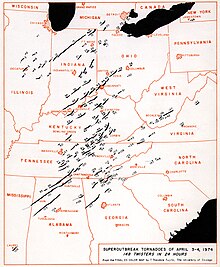
A map of the tornado paths in the Super Outbreak (April 3–4, 1974)
The most record-breaking tornado in recorded history was the
Tri-State Tornado, which roared through parts of
Missouri,
Illinois, and
Indiana on March 18, 1925. It was likely an F5, though tornadoes were not ranked on any scale in that era. It holds records for longest path length (219 miles, 352 km), longest duration (about 3.5 hours), and fastest forward speed for a significant tornado (73 mph, 117 km/h) anywhere on Earth. In addition, it is the deadliest single tornado in United States history (695 dead).
[21] The tornado was also the costliest tornado in history at the time (unadjusted for inflation), but in the years since has been surpassed by several others if population changes over time are not considered. When costs are normalized for wealth and inflation, it ranks third today.
[95]
The deadliest tornado in world history was the
Daultipur-Salturia Tornado in
Bangladesh on April 26, 1989, which killed approximately 1,300 people.
[69] Bangladesh has had at least 19 tornadoes in its history kill more than 100 people, almost half of the
total in the rest of the world.
The most extensive
tornado outbreak on record was the
April 25–28, 2011 tornado outbreak, which spawned 355 confirmed tornadoes over the southeastern United States - 211 of them within a single 24-hour period. The previous record was the
Super Outbreak of 1974 which spawned nearly 148 tornadoes.
While direct measurement of the most violent tornado wind speeds is nearly impossible, since conventional
anemometers would be destroyed by the intense winds and flying debris, some tornadoes have been scanned by
mobile Doppler radar units, which can provide a good estimate of the tornado's winds. The highest wind speed ever measured in a tornado, which is also the highest wind speed ever recorded on the planet, is 301 ± 20 mph (484 ± 32 km/h) in the F5
Bridge Creek-Moore, Oklahoma, tornado which killed 36 people.
[96] Though the reading was taken about 100 feet (30 m) above the ground, this is a testament to the power of the strongest tornadoes.
[2]
Storms that produce tornadoes can feature intense updrafts, sometimes exceeding 150 mph (240 km/h). Debris from a tornado can be lofted into the parent storm and carried a very long distance. A tornado which affected
Great Bend, Kansas, in November 1915, was an extreme case, where a "rain of debris" occurred 80 miles (130 km) from the town, a sack of flour was found 110 miles (180 km) away, and a cancelled check from the Great Bend bank was found in a field outside of
Palmyra, Nebraska, 305 miles (491 km) to the northeast.
[97] Waterspouts and tornadoes have been advanced as an explanation for instances of
raining fish and other animals.
[98]
Safety
Though tornadoes can strike in an instant, there are precautions and preventative measures that people can take to increase the chances of surviving a tornado. Authorities such as the
Storm Prediction Center advise having a pre-determined plan should a tornado warning be issued. When a warning is issued, going to a basement or an interior first-floor room of a sturdy building greatly increases chances of survival.
[99] In tornado-prone areas, many buildings have
storm cellars on the property. These underground refuges have saved thousands of lives.
[100]
Some countries have meteorological agencies which distribute tornado forecasts and increase levels of alert of a possible tornado (such as
tornado watches and
warnings in the United States and Canada).
Weather radios provide an alarm when a severe weather advisory is issued for the local area, though these are mainly available only in the United States. Unless the tornado is far away and highly visible, meteorologists advise that drivers park their vehicles far to the side of the road (so as not to block emergency traffic), and find a sturdy shelter. If no sturdy shelter is nearby, getting low in a ditch is the next best option. Highway overpasses are one of the worst places to take shelter during tornadoes, as the constricted space can be subject to increased wind speed and funneling of debris underneath the overpass.
[101]
Myths and misconceptions
Folklore often identifies a green sky with tornadoes, and though the phenomenon may be associated with severe weather, there is no evidence linking it specifically with tornadoes.
[102] It is often thought that opening windows will lessen the damage caused by the tornado. While there is a large drop in
atmospheric pressure inside a strong tornado, it is unlikely that the pressure drop would be enough to cause the house to explode. Some research indicates that opening windows may actually increase the severity of the tornado's damage.
[citation needed] A violent tornado can destroy a house whether its windows are open or closed.
[103][104]
Another commonly held misconception is that highway overpasses provide adequate shelter from tornadoes. This belief is partly inspired by widely circulated video captured during the
1991 tornado outbreak near
Andover, Kansas, where a news crew and several other people take shelter under an overpass on the
Kansas Turnpike and safely ride out a tornado as it passes by.
[105] However, a highway overpass is a dangerous place during a tornado: the subjects of the video remained safe due to an unlikely combination of events: the storm in question was a weak tornado, did not directly strike the overpass, and the overpass itself was of a unique design.
[105] Due to the
Venturi effect, tornadic winds are accelerated in the confined space of an overpass.
[106] Indeed, in the
1999 Oklahoma tornado outbreak of May 3, 1999, three highway overpasses were directly struck by tornadoes, and at all three locations there was a fatality, along with many life-threatening injuries.
[107] By comparison, during the same tornado outbreak, more than 2000 homes were completely destroyed, with another 7000 damaged, and yet only a few dozen people died in their homes.
[101]
An old belief is that the southwest corner of a basement provides the most protection during a tornado. The safest place is the side or corner of an underground room opposite the tornado's direction of approach (usually the northeast corner), or the central-most room on the lowest floor. Taking shelter in a basement, under a staircase, or under a sturdy piece of furniture such as a workbench further increases chances of survival.
[103][104]
Finally, there are areas which people believe to be protected from tornadoes, whether by being in a city, near a major river, hill, or mountain, or even protected by
supernatural forces.
[108] Tornadoes have been known to cross major rivers, climb mountains,
[109] affect valleys, and have damaged
several city centers. As a general rule, no area is safe from tornadoes, though some areas are more susceptible than others.
[23][103][104]
Ongoing research
Meteorology is a relatively young science and the study of tornadoes is newer still. Although researched for about 140 years and intensively for around 60 years, there are still aspects of tornadoes which remain a mystery.
[110] Scientists have a fairly good understanding of the development of
thunderstorms and mesocyclones,
[111][112] and the meteorological conditions conducive to their formation. However, the step from
supercell (or other respective formative processes) to
tornadogenesis and predicting tornadic vs. non-tornadic mesocyclones is not yet well known and is the focus of much research.
[72]
Also under study are the low-level mesocyclone and the
stretching of low-level
vorticity which tightens into a tornado,
[72] namely, what are the processes and what is the relationship of the environment and the convective storm. Intense tornadoes have been observed forming simultaneously with a mesocyclone aloft (rather than succeeding mesocyclogenesis) and some intense tornadoes have occurred without a mid-level mesocyclone.
[113]
In particular, the role of
downdrafts, particularly the
rear-flank downdraft, and the role of
baroclinic boundaries, are intense areas of study.
[114]
Reliably predicting tornado intensity and longevity remains a problem, as do details affecting characteristics of a tornado during its life cycle and tornadolysis. Other rich areas of research are tornadoes associated with
mesovortices within linear thunderstorm structures and within tropical cyclones.
[115]
Scientists still do not know the exact mechanisms by which most tornadoes form, and occasional tornadoes still strike without a tornado warning being issued.
[116] Analysis of observations including both stationary and mobile (surface and aerial)
in-situ and
remote sensing (passive and active) instruments generates new ideas and refines existing notions.
Numerical modeling also provides new insights as observations and new discoveries are integrated into our physical understanding and then tested in
computer simulations which validate new notions as well as produce entirely new theoretical findings, many of which are otherwise unattainable. Importantly, development of new observation technologies and installation of finer spatial and temporal resolution observation networks have aided increased understanding and better predictions.
[117]
Research programs, including field projects such as the
VORTEX projects (Verification of the Origins of Rotation in Tornadoes Experiment), deployment of
TOTO (the TOtable Tornado Observatory),
Doppler On Wheels (DOW), and dozens of other programs, hope to solve many questions that still plague meteorologists.
[44] Universities, government agencies such as the
National Severe Storms Laboratory, private-sector meteorologists, and the
National Center for Atmospheric Research are some of the organizations very active in research; with various sources of funding, both private and public, a chief entity being the
National Science Foundation.
[92][118] The pace of research is partly constrained by the number of observations that can be taken; gaps in information about the wind, pressure, and moisture content throughout the local atmosphere; and the computing power available for simulation.
[119]
Solar storms similar to tornadoes have been recorded, but it is unknown how closely related they are to their terrestrial counterparts.
[120]
Gallery
-
-
-
-
-
-
-
A rare F0 Tornado in its final stages over the North Sea near Vrångö, Sweden on July 17, 2011










